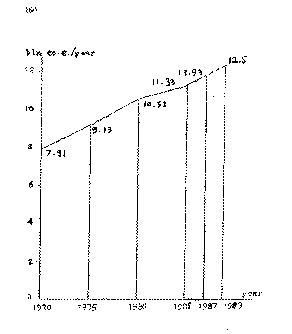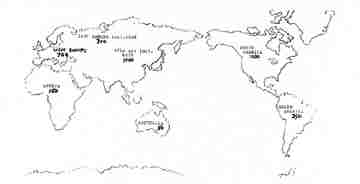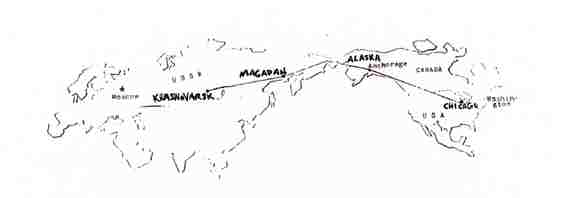 International Journal ofGlobal Energy IssuesVolume 3, No. 3, 1991 Editor–in–Chief M. A. Dorgham The International Journal of Global Energy Issues was initiated by Unesco and is published by Inderscience Enterprises Ltd. with the co–operation of the Moscow International Energy Club, the Academy of East—West Economic Co–operation, the European Academy of Arts, Sciences and Humanities, and the World Federation of Engineering Organizations. Is it possible and expedient to create a global energy network?Yuri Rudenko and V. YershevichUSSR Academy of Sciences, USSR AbstractThe world–wide distribution of primary energy resources does not correspond to the geographical allocation of zones of their consumption. Electricity production and power–plant generating capacity grow everywhere including regions where there arc no resources. Electrical power systems already cover not only individual countries, but also groups of countries, and even entire regions. Therefore, the following problem arises: is it possible and expedient to interconnect regional power systems so as to form a global energy network? The technical facilities for such a network are already available: DC transmission systems with voltages up to ± 750 kV and AC transmission systems with voltage up to 1200 kV. The transfer capacities of such transmission systems can reach 5000—6000 MW. There arc no technical limitations on constructing international DC electrical transmission systems through any straits. The longest existing DC submarine cable link from Finland to Sweden along the bottom of Botnic bay has a voltage of 400 kV and a cable length of about 200 km. The efficiency of large regional and international electrical power system interconnections between East Europe—West Europe, USSR—Canada—USA, USSR—Japan, USSR—China is to be investigated. The five countries participating in these interconnections (USA, USSR, Japan, China, Canada) generate almost 60 per cent of all the electric power produced in the world. Key wordsglobal energy network, energy consumption, primary resources, international interconnection, DC transmission systems. Reference to this article should be made as follows: Rudenko, Y. and Yershevich, V. (1991) 'Is it possible and expedient to create a global energy network?', International Journal of Global Energy Issues, Vol. 3, No. 3, pp. 159—165. 1. What Is the Problem [1, 2]Possibilities for the development of society greatly depend on the energy resources available, and how efficiently they are used. The global consumption of energy resources continues to rise (Figure 1). In 1989 it exceeded 12 billion t.c.e. (the coal equivalent is 7000 kcal/kg). By the first quarter of the twenty–first century the total annual consumption of primary energy in accordance with various scenarios may increase to 17–24 billion t.c.e. [4, 5]; even the maximum value (24 billion t.c.e.) corresponds to a very modest rate of primary energy consumption growth that is typical for the present (a bit less than 2 per cent annually). The annual consumption of energy resources may be expected to become stable only in the second half of the next century. In time, expenditure on the production of transformed (used for consumption) kinds of energy (electrical and thermal energy, light oil products) will increase. Costs will grow either because the cheaper (more accessible) primary energy resources will gradually become exhausted or because their deposits are distributed irregularly over the world. This is illustrated by Table 1, which contains data on proved resources, consumption, and as a result, fossil fuel provision for different regions and for the world as a whole. * Provision is estimated for the 1985 annual consumption level of proved resources. As world energy consumption grows, not only expenditures increase, but ecological problems become more serious. They are caused by enterprises dealing with the extraction, processing, storage, transformation and use of primary energy resources and transformed kinds of energy. These problems may be either regional (acid rains) or global (greenhouse effect).  Figure 1 Growth of world energy resource consumption (up to 1987, data from British Petroleum). The solution to economic and ecological problems that ensures adequate supplies of energy to countries all over the world lies surely in the area of energy conservation; in gradual changes of the structure of primary energy resource consumption (in favour of more efficient and ecologically pure resources for one country, group of countries or entire region); in the sphere of technological improvement that provides more effective (from ecological point of view, too) production and use of final energy. It is necessary to transport energy resources and transformed energy using every possible solution to the economic and ecological problems of energy conservation having in mind the irregular world—wide distribution of primary energy resources (fossil fuels (see Table 1), and other resources such as uranium, hydro), i.e. non—correspondence of their geographical allocation with the regions of their consumption. Energy resources are transported either by railway or by stationary energy systems (electrical power systems and pipelines). Electrical power systems (EPSs) cover not only individual countries, but groups of countries and even regions. They provide not only for tile transport of electrical energy, but smooth out geographical irregularities in consumption, afford mutual aid in cases of emergency and do other things that in the final analysis increase the reliability of the power supply to the consumers. Moreover, solutions many ecological problems are more effective globally than on the basis of individual countries or even groups of countries. The process of national EPS interconnection has been going on for a long time. There exist now such international EPSs as the North American (USA, Canada, Mexico) with an installed capacity of synchronously running power plants above 700 GW; the USSR and East European (Bulgaria, Hungary, Poland, Romania, Czechoslovakia) with an installed capacity of about 400 GW; the Central West European (Austria, Belgium, Italy, Luxembourg, the Netherlands, France, Germany and others) with an installed capacity of about 400 GW; the North Western European (Denmark, Norway, Finland, Sweden) with an installed capacity of about 100 GW. * The possibility of designing the Interconnected All–African EPS and international transmission systems in Asia and South America has been considered. Is there any reason to discuss the expediency of further international interconnection of electrical power systems? Yes, there is. Because fossil fuel deposits and hydro power resources are not located in regions of bulk electrical loads (as has already been stated above), the geographical density of electrical demand is irregular over the globe and there are restrictions on power plant allocation due to either environmental conditions or the 'ecological capacity' of the territory. Table 2 contains average data on electrical energy production and plant capacity in large world regions for the present and forecasts for the future. Levels for 2010 have been estimated with account taken of annual energy production growth: 1.0 to 2.0 per cent in the highly developed countries, essentially more in other regions with the world average being 3.0 to 3.5 per cent. That corresponds to the trends of the last decade (average world annual electrical energy production growth being equal to 3.7 per cent in 1978–87). Comparing this data with that in Table 1 one can see the essential difference between world spatial allocation of fossil fuel resources and the density of electrical power production. It is necessary, besides, to keep in mind the irregularity of the fossil fuels' spatial allocation and the density of power production within regions. Thus (speaking of electrical power production density) in North America 95 per cent of electrical power production is concentrated in the United States and Canada, while the specific power production of northern regions in Canada and Alaska is negligible. The high density of power plants and consumers characteristic for the Soviet Union and Eastern Europe does not extend to eastern and north–eastern regions of the USSR. The biggest power producers in Asia are located in the east of Japan and China. More than two–thirds of the total power production in China is concentrated in one–third of its territory in the east. The regions and capacity of power plants situated there (2010 level) are given in Figure 2. In view of the above it is natural to ask the question: is it possible and expedient to create a global energy network? 2. An International Electrical Power Pool [1, 2]The possibility of expanding national and international EPS depends on the availability of appropriate technical facilities that ensure:
Table 1 Fossil fuel resources, consumption and provision for different regions of the world.
Table 2 Electrical energy production and installed capacity in the main regions of the world.
 Figure 2 Installed capacity of power plants in different regions of the world by 2010, GW. Electrical power transmission systems thousands of kilometers long have already been put into service, specifically:
Research and design work has proved that electrical transmission systems of any voltage, either AC or DC, that can deliver bulk power effectively over very long distances, can be created. The main obstacles facing electrical interconnections between EPSs in different regions of the world are sea straits. However, achievements in DC electrical transmission systems show that there are no technical limitations on international DC electrical transmission construction over ally straits even using present techniques for energy transport by DC. The problem should be solved by comparing the cost of this electrical transmission system and its economic benefits. This conclusion is confirmed by comparing the main characteristics of the straits to be passed by international links (Table 3) with the features of DC links already in operation and under construction: e.g. the HVDC link crossing the Channel (±270 kV), its cable section is 45 km long (eight submarine cables spaced at 1 km one from another); Scagerrack (±250 kV), its cable section exceeds 100 km. The longest DC submarine cable link in the world has a voltage of 400 kV and a cable length about 200 km. It has been put into operation across Botnic Bay (Finland—Sweden) in 1989. It is relevant to mention two engineering projects, not directly related to power transmission, but with a water barrier crossing problem: the tunnel in operation under the Sangarean straits (Japan) and the Channel tunnel (under construction). Using DC transmission systems (overhead and cable) as electrical power system links, either inside regions or between regions, enables the electrical interconnection of EPSs that run with different nominal frequencies (e.g. 50 Hz in Europe, 60 Hz in the United States) or with the same frequency, but with different methods of frequency control. Besides, DC electrical transmission provides for stable power transfer between the interconnected systems under steady—state and emergency conditions, and is practically independent on AC system operation. 3 The Efficiency of International InterconnectionsThe economic efficiency of national and international interconnection of EPSs results from: [1]
Table 3 Straits between countries and continents as barriers to electrical power system links.
Investment savings come from a reduction of the total EPS installed capacity and a more rational structure of generation and distribution (of course, it is necessary to take into consideration additional expenditures for electrical transmission system construction). The total utility generating capacity is reduced because load peaks in the different time zones of EPS occur at different times, a smaller amount of power reserve is necessary for mutual aid in cases of emergency in the EPS, a smaller amount of unbalance compensation is required in the different zones of an EPS (this unbalance between energy production and consumption is due to deviations from forecasts, load jumps and commissioning of plants). A more rational structure for power generation and power plant allocation can be formed on the basis of the irregular distribution of primary energy resources. Savings in operation expenditures come from:
A cutting down on the negative ecological effects of EPS power plants is possible due to:
It is evident that the profits and the beneficial effects to the environment produced by EPS interconnections have to justify their investment. In solving real problems in international EPS interconnections, including the construction of intercontinental links, it is necessary to take into consideration: [2]
In spite of the above—mentioned and other difficulties, dozens of international electrical links exist and operate today and their number continues to grow. The warmer political climate can give an additional impulse to this process. 4 Examples of International InterconnectionsIt is obvious that most practical interest is shown in the possibility and expediency of EPS interconnection in countries that are the largest producers of electrical power, and of the EPS developing on the most energy saturated continents (Table 2). [2] The problems that have been investigated most are those associated with the possibility of an interconnection between Eastern Europe (including the USSR) and Western Europe with the creation of a Unified European EPS [1, 8, 9, etc.] in the future. Special investigations carried out by experts from several countries and discussed by the Energy Committee of the UN European Economic Commission have been devoted to these problems. The interconnection can bc provided by a 400–750–1150kV AC electrical transmission system, a DC transmission system (probably of a similar. voltage) and DC back–to–back stations to provide the possibility of energy exchange with operating conditions independent of the interconnected EPS. Another rather interesting, but not practically investigated, problem is the possibility of constructing links between the USSR Unified EPS and the North American EPS across the Bering straits (Figure 3). With existing power plant and load centre allocation in neighbouring Soviet, US and Canadian territories (Yakutia, Chukotka, Alaska, Northern Canada) which have an extremely low energy saturation, the construction of an international link does not seem to he practical from the economic point of view. However the construction of large power plants in the north–east of the Soviet Union and/or in Alaska (e.g. using tidal energy), as well as the development of electrical interconnections between these EPS, could prove to be efficient. In accordance with the last developments in China's EPS (production has increased annually by 9 per cent during the last five years, and it ranks fourth in the world list of electrical power production countries) it might be possible at some time to construct an international electrical transmission system linking China and the Soviet Union. The efficiency of the USSR—Japan electrical transmission system which crosses two straits that are small in depth and width (Table 2) should be analysed. The USSR—China and USSR—Japan electrical transmission systems would be of great interest once the question of the USSR—USA transmission project has been settled.  Figure 3 USSR—USA transmission line. Then we would have one consolidated operation of the EPS of the largest energy–producing countries in the world (the United States, the Soviet Union, Japan and China), which provide almost 60 per cent of world energy production. It would be useful to consider the possibilities of international electrical interconnections of EPSs in South East Asia, e.g. between Vietnam, Laos, Cambodia and Thailand. 5 Feasibility of International EPS InterconnectionIt is known that research and design work must be carried out to answer the question: is it possible and expedient to accomplish or expand an international electrical interconnection of EPSs. This package of research and design work for interconnecting the EPSs of countries or groups of countries will most probably amount to the following: [1]
6 ConclusionsThis paper presents general considerations on the possibility and effectiveness of expanding the bounds of existing EPSs or of creating new international interconnected power pools. The development of international interconnection of EPSs is the natural consequence of the industrial development or individual countries and groups of countries. This process will probably result sooner or later in the problem of creating a Unified EPS embracing all or almost all countries and continents on Earth. It should be noted that creation of a Unified EPS of the World by constructing international and intercontinental high voltage links was proposed in 1987, 1988 and in 1989 by the head of international organisation 'Global Electrical Networks', Mr. P. Meisen of the United States. Earlier, in 1971, a similar idea was suggested by the United Nations, and in 1984 by the International Conference on large Electric Systems (ICLES, CIGRE). It is believed that studying the possibility of creating a Unified EPS of the World and probable stages in its development in one or other international scientific organisation (e.g. the International Applied System Analysis Institute in Austria, or the Moscow International Energy Club) will undoubtedly be of educational or organisational value. It should be emphasized once again that the creation of a Unified EPS of the World should not be an end in itself; rather, it should be the natural result or a gradual development of actual EPS international interconnection that proves to be beneficial economically, ecologically, and politically. Finally, it should be noted that expansion of the territory of the EPS through international interconnections will most probably result in the creation of a Unified EPS of the World; in turn this will require an assessment of whether it is possible and expedient to create gradually (step by step) a World Energy System, including extracting, processing, storing, transferring, and distributing various energy resources and transformed kinds of energy. In such a system the Unified EPS of the World would be just one component. The reasons behind these statements are similar to those in section 1 on expansion of the territory of the EPS, the main one among others being irregular industrial development and irregular primary energy resource distribution over the world. References
Biographical notes:Yuri Rudenko graduated from the Industrial Institute in Leningrad in 1955 as an electrical power engineer. He gained his doctorate in power systems reliability at the Siberian Energy Institute of the Siberian Branch of the USSR Academy of Sciences (Irkutsk) in 1972. In 1977 he was elected a corresponding member, in 1987 a full member, of the Academy of Sciences of the USSR. His scientific interests include the general energy problem and energy systems reliability. Victor Yershevich graduated from the Technical University in Kharkov (Ukraine) as an electrical power engineer, gained his doctorate in power systems planning at the Siberian Energy Institute of the Siberian Brunch of the USSR Academy of Sciences (Irkutsk) in 1988. His scientific interests include electrical power systems development in the USSR and in the world. |
||||||||||||||||||||||||||||||||||||||||||||||||||||||||||||||||||||||||||||||||||||||||||||||||||||||||||||||||||||||||||||||||||||||||||||||||||||||||||||||||||||||||||||||||||||||||||||||||||||||||||||||